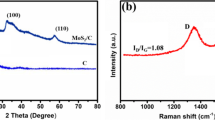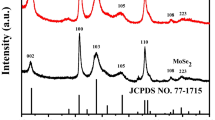Abstract
Developing advanced MoS2 anode material for sodium ion battery is still a big challenge since it is hindered by poor cycling stability and rate capability owing to huge volume variation during charge/discharge processes and low conductivity. In this work, three-dimensional porous networks consisting of several-layered MoS2/C nanosheets are synthesized via a facile freeze-drying approach using NaCl as template. MoS2/C nanosheet networks demonstrate a high reversible capacity of 389 mAh g−1 and maintain 370 mAh g−1 after 100 cycles at 100 mA g−1, indicating excellent cycling stability. Good rate properties are also achieved with reversible capacities of 292, 256, 223, 174 mAh g−1 at 1, 2, 4, 6 A g−1, respectively. The excellent electrochemical performance can be ascribed to the unique three-dimensional networks consisting of few-layered MoS2 nanosheets, which facilitates sodium ion diffusion via near-surface reaction. Moreover, the robust three-dimensional carbon matrix can not only provide a conductive network, but also buffer the strain and maintain the electrode integrity during repeated sodiation/desodiation process. This strategy presents a new path for fabricating low-cost and high-yield three-dimensional metal sulfide (phosphide)/carbon composites for applications in energy-related fields and beyond.






Similar content being viewed by others
References
Li H, Wang Z, Chen L, Huang X (2009) Research on advanced materials for Li-ion batteries. Adv Mater 21:4593–4607
Hwang JY, Myung ST, Sun YK (2017) Sodium-ion batteries: present and future. Chem Soc Rev 46:3529–3614
Dipan K, Elahe T, Victor D, Nazar LF (2015) The emerging chemistry of sodium ion batteries for electrochemical energy storage. Angew Chem Int Ed 54:3431–3448
Yabuuchi N, Kubota K, Dahbi M, Komaba S (2014) Research development on sodium-ion batteries. Chem Rev 114:11636–11682
Pang Y, Zhang S, Liu L, Liang J, Sun Z, Wang Y, Xiao C, Ding D, Ding S (2017) Few-layer MoS2 anchored at nitrogen-doped carbon ribbons for sodium-ion battery anodes with high rate performance. J Mater Chem A 5:17963–17972
Alcántara R, Jiménez-Mateos JM, Lavela P, Tirado JL (2001) Carbon black: a promising electrode material for sodium-ion batteries. Electrochem Commun 3:639–642
Komaba S, Murata W, Ishikawa T, Yabuuchi N, Ozeki T, Nakayama T, Ogata A, Gotoh K, Fujiwara K (2011) Electrochemical Na insertion and solid electrolyte Interphase for hard-carbon electrodes and application to Na-ion batteries. Adv Funct Mater 21:3859–3867
Cao Y, Xiao L, Sushko ML, Wang W, Schwenzer B, Xiao J, Nie Z, Saraf LV, Yang Z, Liu J (2016) Sodium ion insertion in hollow carbon nanowires for battery applications. Nano Lett 12:3783–3787
Yang W, Kai H, Zhu Y, Han F, Xu Y, Matsuda I, Ishii Y, Cumings J, Wang C (2014) Expanded graphite as superior anode for sodium-ion batteries. Nat Commun 5:4033
Li W, Zeng L, Yang Z, Gu L, Wang J, Liu X, Cheng J, Yu Y (2014) Free-standing and binder-free sodium-ion electrodes with ultralong cycle life and high rate performance based on porous carbon nanofibers. Nanoscale 6:693
Komaba S, Matsuura Y, Ishikawa T, Yabuuchi N, Murata W, Kuze S (2012) Redox reaction of Sn-polyacrylate electrodes in aprotic Na cell. Electrochem Commun 21:65–68
Qian J, Chen Y, Wu L, Cao Y, Ai X, Yang H (2012) High capacity Na-storage and superior cyclability of nanocomposite Sb/C anode for Na-ion batteries. Chem Commun 48:7070–7072
Zhang Q, He H, Huang X, Yan J, Tang Y, Wang H (2018) TiO2@C nanosheets with highly exposed (001) facets as a high-capacity anode for Na-ion batteries. Chem Eng J 332:57–65
He H, Zhang Q, Wang H, Zhang H, Li J, Peng Z, Tang Y, Shao M (2017) Defect-rich TiO2−δ nanocrystals confined in a mooncake-shaped porous carbon matrix as an advanced Na ion battery anode. J Power Sources 354:179–188
Zhang Y, Lim YV, Huang S, Pam ME, Wang Y, Ang LK, Shi Y, Yang HY (2018) Tailoring NiO nanostructured arrays by sulfate anions for sodium-ion batteries. Small 14:1800898
Choi SH, Ko YN, Lee J-K, Kang YC (2015) 3D MoS2-graphene microspheres consisting of multiple nanospheres with superior sodium ion storage properties. Adv Funct Mater 25:1780–1788
Eames C, Islam MS (2014) Ion intercalation into two-dimensional transition-metal carbides: global screening for new high-capacity battery materials. J Am Chem Soc 136:16270–16276
Sun D, Ye D, Liu P, Tang Y, Guo J, Wang L, Wang H (2018) MoS2/graphene nanosheets from commercial bulky MoS2 and graphite as anode materials for high rate sodium-ion batteries. Adv Energy Mater 8:1702383
Ren W, Zhang H, Guan C, Cheng C (2017) Ultrathin MoS2 nanosheets@metal organic framework-derived N-doped carbon nanowall arrays as sodium ion battery anode with superior cycling life and rate capability. Adv Funct Mater 27:1702116
Kumar NA, Dar MA, Gul R, Baek JB (2015) Graphene and molybdenum disulfide hybrids: synthesis and applications. Mater Today 18:286–298
Lu Y, Zhao Q, Zhang N, Lei K, Li F, Chen J (2016) Facile spraying synthesis and high-performance sodium storage of mesoporous MoS2/C microspheres. Adv Funct Mater 26:911–918
Li Y, Liang Y, Hernandez FCR, Yoo HD, An Q, Yao Y (2015) Enhancing sodium-ion battery performance with interlayer-expanded MoS2-PEO nanocomposites. Nano Energy 15:453–461
Li X, Feng Z, Zai J, Ma Z-F, Qian X (2018) Incorporation of Co into MoS2/graphene nanocomposites: one effective way to enhance the cycling stability of Li/Na storage. J Power Sources 373:103–109
Su D, Dou S, Wang G (2015) Ultrathin MoS2 nanosheets as anode materials for sodium-ion batteries with superior performance. Adv Energy Mater 5:1401205
Che Z, Li Y, Chen K, Wei M (2016) Hierarchical MoS2@RGO nanosheets for high performance sodium storage. J Power Sources 331:50–57
Yang W, He L, Tian X, Yan M, Yuan H, Liao X, Meng J, Hao Z, Mai L (2017) Microdevices: carbon-MEMS-based alternating stacked MoS2@rGOCNT micro-supercapacitor with high capacitance and energy density. Small 13:1700639
Xiong F, Cai Z, Qu L, Zhang P, Yuan Z, Asare OK, Xu W, Lin C, Mai L (2015) Three-dimensional crumpled reduced graphene oxide/MoS2 nanoflowers: a stable anode for lithium-ion batteries. ACS Appl Mater Interfaces 7:12625–12630
Zhu C, Mu X, van Aken PA, Yu Y, Maier J (2014) Single-layered ultrasmall nanoplates of MoS2 embedded in carbon nanofibers with excellent electrochemical performance for lithium and sodium storage. Angew Chem Int Ed Engl 53:2152–2156
Hu X, Chen J, Zeng G, Jia J, Cai P, Chai G, Wen Z (2017) Robust 3D macroporous structures with SnS nanoparticles decorating nitrogen-doped carbon nanosheet networks for high performance sodium-ion batteries. J Mater Chem A 5:23460–23470
Qin J, He C, Zhao N, Wang Z, Shi C, Liu EZ, Li J (2014) Graphene networks anchored with Sn@graphene as lithium ion battery anode. ACS Nano 8:1728–1738
Qin J, Wang T, Liu D, Liu E, Zhao N, Shi C, He F, Ma L, He C (2018) A top-down strategy toward SnSb in-plane nanoconfined 3D N-doped porous graphene composite microspheres for high performance Na-ion battery anode. Adv Mater 30:1704670
Hu Z, Wang L, Zhang K, Wang J, Cheng F, Tao Z, Chen J (2014) MoS2 nanoflowers with expanded interlayers as high-performance anodes for sodium-ion batteries. Angew Chem Int Ed Engl 53:12794–12798
Zhao C, Yu C, Qiu B, Zhou S, Zhang M, Huang H, Wang B, Zhao J, Sun X, Qiu J (2018) Ultrahigh rate and long-life sodium-ion batteries enabled by engineered surface and near-surface reactions. Adv Mater 30:1702486
Teng Y, Zhao H, Zhang Z, Zhao L, Zhang Y, Li Z, Xia Q, Du Z, Świerczek K (2017) MoS2 nanosheets vertically grown on reduced graphene oxide via oxygen bonds with carbon coating as ultrafast sodium ion batteries anodes. Carbon 119:91–100
Wang J, Luo C, Gao T, Langrock A, Mignerey AC, Wang C (2015) An advanced MoS2/carbon anode for high-performance sodium-ion batteries. Small 11:473–481
Zhang P, Qin F, Zou L, Wang M, Zhang K, Lai Y, Li J (2017) Few-layered MoS2/C with expanding d-spacing as a high-performance anode for sodium-ion batteries. Nanoscale 9:12189–12195
David L, Bhandavat R, Singh G (2014) MoS2/graphene composite paper for sodium-ion battery electrodes. ACS Nano 8:1759–1770
Lacey SD, Wan J, Cresce AVW, Russell SM, Dai J, Bao W, Xu K, Hu L (2015) Atomic force microscopy studies on molybdenum disulfide flakes as sodium-ion anodes. Nano Lett 15:1018–1024
Xia Q, Tan Q (2018) MoS2 nanosheets strongly coupled with cotton-derived carbon microtubes for ultrafast sodium ion insertion. Mater Lett 228:285–288
Zhang S, Yu X, Yu H, Chen Y, Gao P, Li C, Zhu C (2014) Growth of ultrathin MoS2 nanosheets with expanded spacing of (002) plane on carbon nanotubes for high-performance sodium-ion battery anodes. ACS Appl Mater Interfaces 6:21880–21885
Xie X, Ao Z, Su D, Zhang J, Wang G (2015) MoS2/graphene composite anodes with enhanced performance for sodium-ion batteries: the role of the two-dimensional heterointerface. Adv Funct Mater 25(9):1393–1403
Wei Q, Chen T, Pan L, Niu L, Hu B, Li D, Li J, Sun Z (2015) MoS2-reduced graphene oxide composites via microwave assisted synthesis for sodium ion battery anode with improved capacity and cycling performance. Electrochim Acta 153:55–61
Zhou F, Xin S, Liang HW, Song LT, Yu SH (2014) Carbon nanofibers decorated with molybdenum disulfide nanosheets: synergistic lithium storage and enhanced electrochemical performance. Angew Chem Int Ed Engl 53:11552–11556
Wang YX, Chou SL, Liu HK, Dou SX (2013) Reduced graphene oxide with superior cycling stability and rate capability for sodium storage. Carbon 57:202–208
Wang YX, Chou SL, Wexler D, Liu HK, Dou SX (2014) High-performance sodium-ion batteries and sodium-ion pseudocapacitors based on MoS2/graphene composites. Chemistry 20:9607
Kong D, Cheng C, Wang Y, Huang ZX, Lim YV, Liu B, Ge Q, Yang HY (2017) Fe3O4 quantum dots decorated MoS2 nanosheet arrays on graphite paper as free-standing sodium-ion batteries anode. J Mater Chem A 5:9122–9131
Xu M, Yi F, Niu Y, Xie J, Hou J, Liu S, Hu W, Li Y, Li CM (2015) Solvent-mediated directionally self-assembling MoS2 nanosheets into a novel worm-like structure and its application in sodium batteries. J Mater Chem A 3:9932–9937
Xu G, Liu P, Ren Y, Huang X, Peng Z, Tang Y, Wang H (2017) Three-dimensional MoO2 nanotextiles assembled from elongated nanowires as advanced anode for Li ion batteries. J Power Sources 361:1–8
He H, Sun D, Zhang Q, Fu F, Tang Y, Guo J, Shao M, Wang H (2017) Iron doped cauliflower-like rutile TiO2 with superior sodium storage properties. ACS Appl Mater Interfaces 9:6093–6103
Sun D, Tang Y, Ye D, Yan J, Zhou H, Wang H (2017) Tuning the morphologies of MnO/C hybrids by space constraint assembly of Mn-MOFs for high performance Li ion batteries. ACS Appl Mater Interfaces 9:5254–5262
He H, Gan Q, Wang H, Xu G-L, Zhang X, Huang D, Fu F, Tang Y, Amine K, Shao M (2018) Structure-dependent performance of TiO2/C as anode material for Na-ion batteries. Nano Energy 44:217–227
He H, Huang D, Pang W, Sun D, Wang Q, Tang Y, Ji X, Guo Z, Wang H (2018) Plasma-induced amorphous shell and deep cation-site S doping endow TiO2 with extraordinary sodium storage performance. Adv Mater 30:1801013
Mortazavi M, Wang C, Deng J, Shenoy VB, Medhekar NV (2014) Ab initio characterization of layered MoS2 as anode for sodium-ion batteries. J Power Sources 268:279–286
Acknowledgements
This work was financially supported by the National Nature Science Foundation of China (Nos. 21571189 and 21771062), Science and Technology Major Project of Hunan Province, China (2017GK1040), Science and Technology Plan Project of Hunan Province, China (Nos. 2016TP1007 and 2017TP1001), Hunan Provincial Natural Science Foundation of China (No. 2018JJ4002) and Innovation-Driven Project of Central South University (No. 2016CXS009).
Author information
Authors and Affiliations
Corresponding author
Electronic supplementary material
Below is the link to the electronic supplementary material.
Rights and permissions
About this article
Cite this article
Zhang, R., Li, H., Sun, D. et al. Facile preparation of robust porous MoS2/C nanosheet networks as anode material for sodium ion batteries. J Mater Sci 54, 2472–2482 (2019). https://doi.org/10.1007/s10853-018-2991-z
Received:
Accepted:
Published:
Issue Date:
DOI: https://doi.org/10.1007/s10853-018-2991-z




